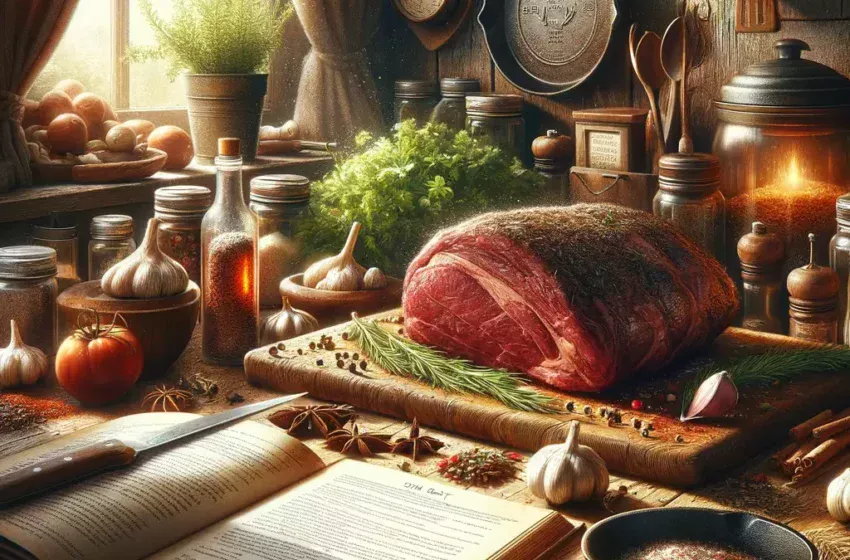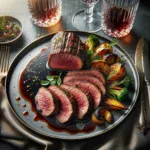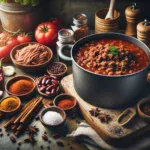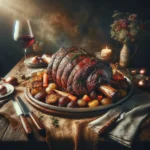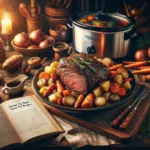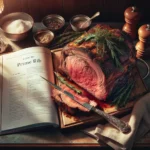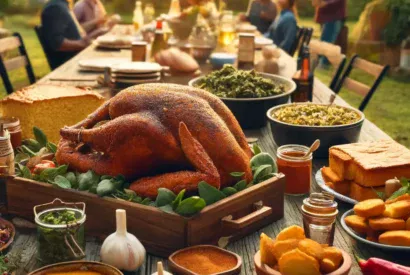As a food reviewer, I’ve had the privilege of tasting a wide variety of dishes, but few have captured my palate quite like a well-prepared elk roast. Today, I’ll be sharing a simple yet delicious elk roast recipe that is sure to impress both game meat enthusiasts and novices alike. Whether you’re an experienced hunter looking to showcase your latest catch or a home cook curious about game meats, this elk roast recipe offers a delightful culinary experience.
What is Elk Roast?
Elk roast refers to a large cut of elk meat, typically from the animal’s shoulder or rear, that is roasted to tender perfection. Elk meat is known for its rich, slightly sweet flavor and leaner profile compared to beef. Cooking elk roast requires a bit of finesse to ensure it stays moist and flavorful, as the low fat content means it can dry out if overcooked.
Succulent Elk Roast Recipe: A Food Reviewer’s Guide to Crafting the Perfect Game Dinner
- Preparation Time
15 minutes - Cooking Time
2-3 hours - Serves
4 adults - Difficulty
Intermediate
Ingredients
- Elk Roast: 3-4 pounds of elk roast (shoulder or rump)
Marinade:
- 1/4 cup olive oil
- 1/4 cup soy sauce
- 1/4 cup red wine vinegar
- 3 cloves garlic, minced
- 1 tablespoon rosemary, chopped
- 1 tablespoon thyme, chopped
- Salt and pepper to taste
Vegetables (optional for roasting):
- 2 carrots, peeled and chopped
- 2 potatoes, peeled and chopped
- 1 onion, peeled and quartered
Instructions
- Prepare the Marinade
- In a bowl, combine olive oil, soy sauce, red wine vinegar, minced garlic, rosemary, thyme, salt, and pepper. Whisk together until well combined.
- Marinate the Elk Roast
- Place the elk roast in a large resealable bag or a deep dish. Pour the marinade over the elk, ensuring it is fully coated. Seal or cover and refrigerate for at least 4 hours, preferably overnight, to allow the flavors to penetrate the meat.
- Preheat the Oven
- Preheat your oven to 325°F (165°C). This lower temperature is key to slowly cooking the elk roast, ensuring it becomes tender without drying out.
- Prepare for Roasting
- If you’re including vegetables, place them at the bottom of a roasting pan. Remove the elk roast from the marinade and place it on top of the vegetables. Pour any remaining marinade over the elk.
- Roast the Elk
- Cover the roasting pan with aluminum foil or a lid and place it in the preheated oven. Cook for about 2-3 hours, or until the elk roast reaches an internal temperature of 145°F (63°C) for medium-rare.
- Rest Before Serving
- Remove the elk roast from the oven and let it rest for 10-15 minutes before slicing. This allows the juices to redistribute, ensuring a moist and flavorful roast.
Pro Tips
- Marinating is Key: The longer you can marinate the elk roast, the more tender and flavorful it will be.
- Avoid Overcooking: Keep a close eye on the internal temperature to prevent the elk from becoming tough.
- Serving Suggestion: Slice the elk roast thinly against the grain for the tenderest eating experience.
Why You Will Love Elk Roast Recipe
- Rich Flavor: Elk meat has a unique taste that’s both rich and lean, offering a delightful change from traditional beef roasts.
- Healthy Option: Elk is a great source of protein and is lower in fat than many other red meats.
- Special Occasion Worthy: This elk roast recipe is perfect for impressing guests or celebrating a special event.
How to Eat Elk Roast
Enjoy your elk roast sliced thinly, accompanied by the roasted vegetables and perhaps a side of mashed potatoes or a fresh salad. Pair it with a robust red wine for an exquisite dining experience.
Conclusion
This elk roast recipe represents a fantastic way to enjoy the rich flavors of game meat, whether you’re a seasoned game eater or new to the experience. With its simple steps and mouthwatering results, it’s a recipe that promises to elevate your cooking repertoire.
If you loved this elk roast recipe, don’t forget to share it with friends and family!
You Can Also Read:- Ina Garten Prime Rib Recipe
FAQ On Elk Roast Recipe
FAQs: Elk Roast Recipe
1. What is elk roast?
Elk roast is a large cut of elk meat, typically from the shoulder or rump, roasted to achieve a tender and flavorful dish.
2. How long should I marinate the elk roast?
For best results, marinate the elk roast for at least 4 hours, though overnight marination is preferred.
3. Can I substitute elk with another type of meat?
Yes, if elk is not available, you can substitute it with venison or a lean cut of beef, though the flavor profile will vary.
4. What temperature should elk roast be cooked to?
For medium-rare, cook the elk roast until it reaches an internal temperature of 145°F (63°C).
5. How can I prevent the elk roast from drying out?
Marinate it before cooking, use a low cooking temperature, and avoid overcooking.
6. Can I cook the elk roast in a slow cooker?
Yes, you can adapt the recipe for a slow cooker. Cook on low for 6-8 hours or on high for 3-4 hours.
7. What side dishes pair well with elk roast?
Roasted vegetables, mashed potatoes, and fresh salads complement elk roast well.
8. Is elk meat healthier than beef?
Elk meat is leaner than beef and is a good source of protein, making it a healthier option for many.
9. How should leftovers be stored?
Store leftover elk roast in an airtight container in the refrigerator for up to 3-4 days.
10. Can elk roast be frozen?
Yes, you can freeze cooked elk roast for up to 3 months. Thaw in the refrigerator before reheating.
11. What’s the best way to reheat elk roast?
Reheat gently in the oven or on the stovetop with a bit of broth to keep it moist.
12. Why is my elk roast tough?
It may be due to overcooking or not marinating long enough. Elk is lean and requires careful cooking to stay tender.
13. Can I use bottled marinade for elk roast?
Yes, but homemade marinades typically offer better flavor and fewer additives.
14. What’s the difference between elk roast and beef roast? Elk roast is leaner and has a distinct, slightly sweet flavor compared to beef.
15. How do I know when the elk roast is done?
Use a meat thermometer to check for the desired internal temperature.
16. Do I need to sear the elk roast before roasting?
Searing is not necessary for this recipe, but it can add flavor and texture.
17. Can I include other vegetables in the roast?
Absolutely. Feel free to add other root vegetables or your favorites to the roasting pan.
18. How do I make gravy from the pan drippings?
Skim the fat, then simmer the drippings with flour or cornstarch on the stove, stirring until thickened.
19. Can I marinate elk roast for longer than 24 hours?
It’s best not to marinate for over 24 hours as the meat can become mushy.
20. What herbs and spices pair well with elk?
Rosemary, thyme, garlic, and juniper berries enhance elk’s natural flavors.
21. Is elk roast expensive?
Elk meat can be pricier than beef, depending on your location and the source of the meat.
22. How can I ensure even cooking of the elk roast?
Let the elk roast come to room temperature before cooking and rotate the pan halfway through roasting.
23. Can I cook elk roast from frozen?
It’s best to fully thaw elk roast before cooking to ensure even cooking.
24. What wine pairs well with elk roast? Robust red wines like Cabernet Sauvignon or Syrah complement the rich flavors of elk roast.
25. Can I make elk roast in an Instant Pot?
Yes, you can adapt the recipe for an Instant Pot. Use the meat/stew setting and adjust the time based on the size of the roast.
26. How do I slice elk roast?
Slice against the grain in thin slices to ensure tenderness.
27. Can I use this recipe for elk steak?
Yes, but adjust the cooking time as steaks will cook faster than a roast.
28. What’s the nutritional value of elk meat?
Elk meat is high in protein and minerals like iron and zinc, with lower fat content than beef.
29. Can elk roast be barbecued?
Yes, though careful attention to avoid overcooking is necessary due to its lean nature.
30. Why does elk meat taste different from beef?
Elk meat has a unique flavor profile due to its diet and natural habitat

